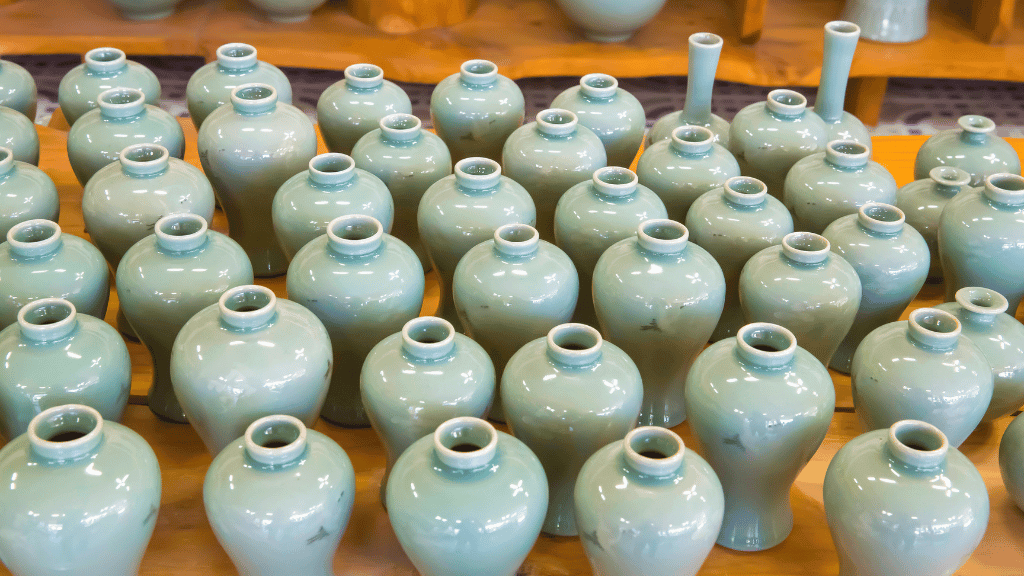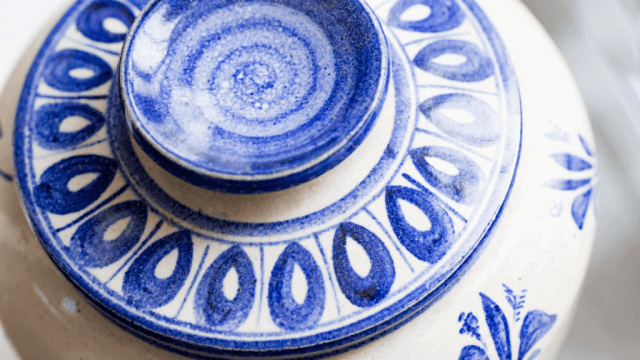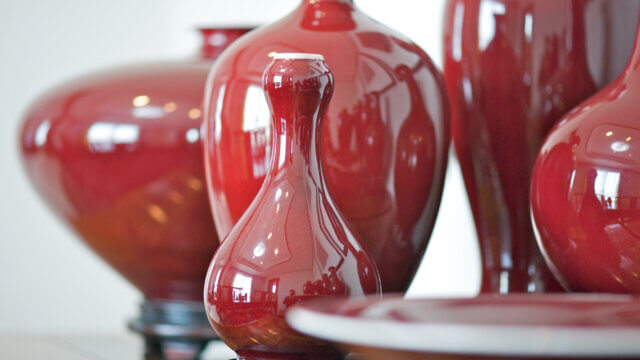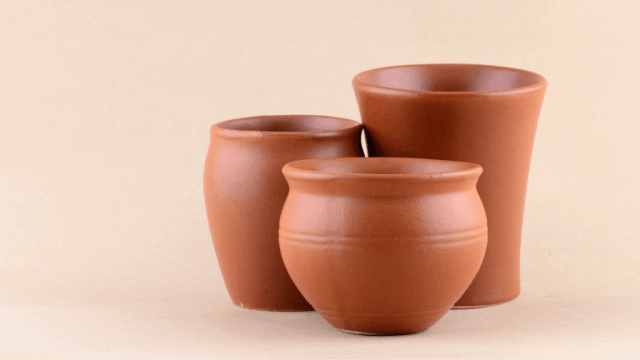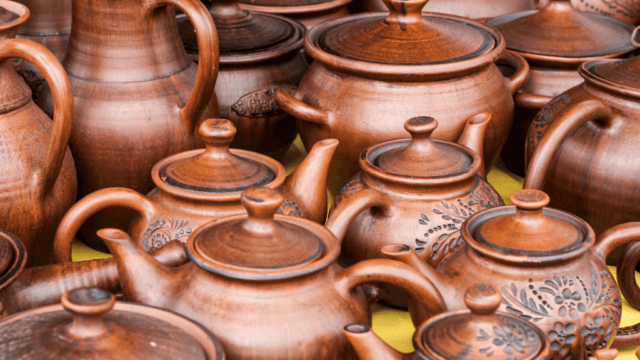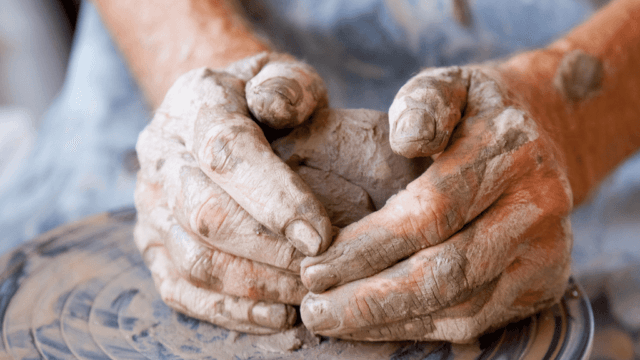Celadon pottery is a ceramic characterized by its jade-green glaze and intricate designs.
From China, celadon pottery gained popularity across Asia, particularly in Korea and Thailand.
Its distinctive glaze is achieved through an oxidation process using iron oxide as a colorant, resulting in a wide range of green hues on the final product.
Origins of Celadon Pottery
Celadon pottery originated in China during the late Eastern Han dynasty (25-220 CE) and flourished during the Song (960-1279) and Yuan (1271-1368) dynasties.
Over time, its popularity spread across Asia, with notable contributions from Korea and Thailand.
Characteristics of Celadon Pottery
Unique Jade-Green Glaze
The defining feature of celadon pottery is its jade-green glaze, which ranges from pale green to deep emerald hues.
This glaze is achieved through an oxidation process, using iron oxide as a colorant, and fired in a reducing atmosphere to produce the desired color and finish.
Intricate Designs and Shapes
Celadon pottery is known for its intricate designs, often inspired by nature, such as flowers, animals, and landscapes.
These designs are either molded or hand-carved into the pottery before glazing.
In addition to decorative pieces, celadon pottery includes practical objects like bowls, plates, and tea sets with similar motifs.
Production Techniques
Clay Preparation
High-quality clay is essential for producing fine celadon pottery.
The clay is typically refined and aged to eliminate impurities, resulting in a smooth, homogeneous texture suitable for shaping and carving.
Forming and Shaping
Celadon pottery is shaped using various techniques, such as wheel-throwing, molding, or handbuilding.
Once formed, the piece is allowed to dry until it reaches the leather-hard stage, at which point it can be carved, burnished, or given additional details.
Biscuit Firing and Glazing
The pottery is first fired without glaze in a process called biscuit firing to harden the clay and remove any residual moisture.
After cooling, the piece is coated in the celadon glaze, made from a mixture of clay, water, and iron oxide, which determines its final color.
Gloxinia Firing
Once glazed, the pottery is fired again in a reducing atmosphere, limiting the amount of oxygen in the kiln.
This process, known as gloxinia firing, affects the iron oxide in the glaze and produces the characteristic jade-green color.
Celadon Pottery in Different Cultures
While Chinese celadon pottery is historically revered, Korean and Thai celadon pottery also gained recognition for their distinct regional styles.
Korean celadon, known as Goryeo celadon, often features inlaid or slip-painted designs, while Thai celadon is known for its distinct crackled glaze and unique shapes inspired by local culture.
Understanding the Celadon Glaze
The celadon glaze is made from a mixture of clay, water, and iron oxide.
Its green color is due to the presence of iron oxide, which, when fired in a reducing atmosphere, produces different shades of green.
The exact hue depends on the amount of iron oxide and firing conditions.
Some celadon glazes also exhibit crackling, which involves a network of fine hairline cracks in the glaze, adding to the pottery’s unique appearance.
History of Celadon in Korean and Thai Pottery
Goryeo Celadon (Korean Celadon)
Korea adopted the celadon technique from China during the Goryeo dynasty (918-1392).
Goryeo celadon is well-known for its delicate inlaid or slip-painted decorations, resembling the patterns seen in fine embroidery.
The glaze of Goryeo celadon is usually a vivid blue-green color, and pieces often have an elegant, slender form.
Sawankhalok (Thai Celadon)
Thai celadon pottery, also known as Sawankhalok ware, dates back to the 14th and 15th centuries.
It was initially influenced by Chinese celadon but evolved into a distinct regional style.
Thai celadon is characterized by a beautiful crackled glaze, unique shapes inspired by local culture, and bold designs often using elephant, fish, and floral motifs.
Appreciating Celadon Pottery
Across cultures, celadon pottery has been admired for centuries for its craftsmanship, elegance, and intricate designs.
When handling celadon pottery, pay attention to the glaze’s hue, the workmanship of the decorations, and the piece’s overall symmetry and form.
Celadon pottery holds a unique place in the world of ceramics, making it a fascinating subject for enthusiasts, collectors, and anyone interested in learning about the technical and artistic achievements of historical potters.
Caring for Your Celadon Pottery
Although celadon pottery is made from durable materials, proper care is essential.
To clean your celadon pieces, use a soft cloth dipped in mild soapy water and gently wipe the surface.
Avoid abrasive cleaners or scrubbing, as this can damage the glaze.
If your pottery has crackles in the glaze, it may be susceptible to staining.
To minimize this, avoid direct contact with strongly-colored liquids or foods.
Finally, store and display your celadon pottery in a safe and secure location, away from harsh light or excessive humidity.
Frequently Asked Questions About Celadon Pottery
In this FAQ section, we will address some common questions related to celadon pottery, its unique attributes, and essential care tips to expand your knowledge and help you appreciate these beautiful ceramic works.
What is the significance of the jade-green color of celadon pottery?
The jade-green color of celadon pottery is a result of the iron oxide in the glaze reacting with the firing process in a reducing atmosphere.
Jade is a valuable and highly sought-after stone in many Asian cultures, and the celadon glaze was developed to mimic the beauty and elegance of jade on ceramics.
What types of objects are made from celadon pottery?
Celadon pottery includes a wide range of objects, from decorative pieces such as vases, figurines, and wall hangings, to functional items like bowls, plates, and tea sets.
Potters have used the celadon technique to create a diverse array of forms and styles suited to various uses and cultural preferences.
How can I distinguish between Chinese, Korean, and Thai celadon pottery?
Each type of celadon pottery exhibits specific features.
Chinese celadon is often simpler in form with subtle designs and glazes that vary from pale green to deep emerald.
Korean Goryeo celadon stands out for its distinct blue-green glaze, embroidered-like patterns, and slender forms.
Thai Sawankhalok celadon is known for its unique crackled glaze, bold designs, and shapes influenced by local culture.
Can I use celadon pottery to serve food and beverages?
Yes, you can use celadon pottery for serving food and beverages, as it is made from durable and food-safe materials.
However, be cautious if the glaze features crackling, as it may stain when in contact with strongly-colored liquids or foods.
Always handle your celadon pottery with care, clean it gently, and avoid sudden changes in temperature to prevent damage.
How can I identify authentic and high-quality celadon pottery?
Authentic, high-quality celadon pottery can be identified by examining several attributes, such as the vibrancy and variation of the glaze color, the craftsmanship of the designs, and the pottery’s overall form and symmetry.
Additionally, paying attention to the maker’s marks and researching the history of the piece can provide further insights into its authenticity and quality.
